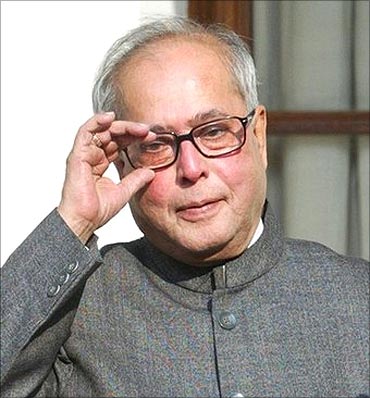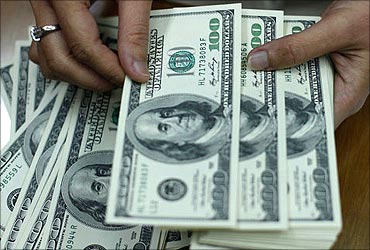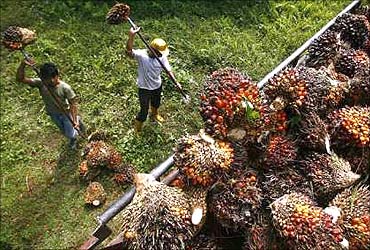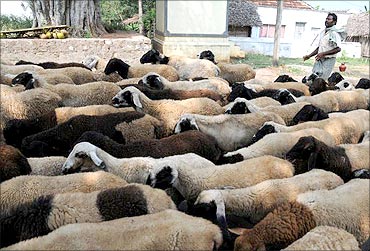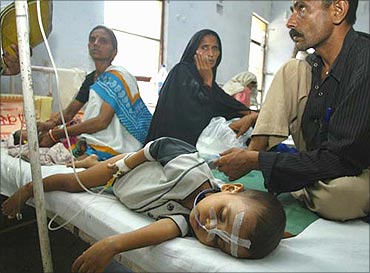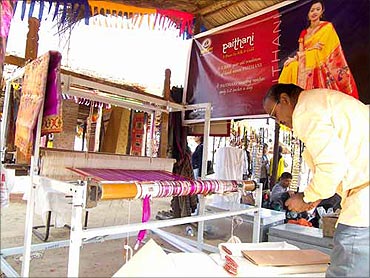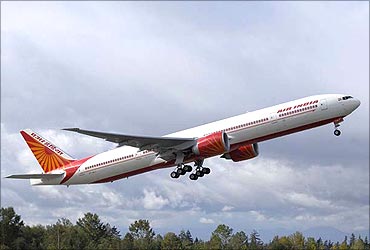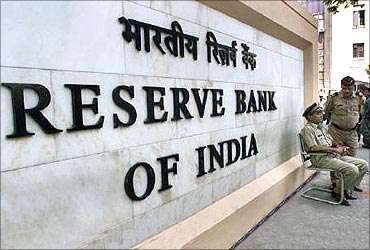 | « Back to article | Print this article |
Budget a tightrope
The UPA government's budget for 2011/12 can be termed as a pragmatic and forward looking balanced effort, across the social spectrum.
While the urban middle class gets some relief by way of an increase in income tax exemption levels, a slew of initiatives have also been announced for the populace in rural markets.
Some of the initiatives are aimed specifically at the poorer sections of the society.
The Finance Minister, Pranab Mukherjee has clearly indicated that the Indian economy is poised for a 9 percent growth in the 2011-12.
Several promises have been made ranging from implementation of Direct Tax Code to finalizing Goods and Services Act.
These will be done by variety of committees and task forces, hope the process is speeded up and the time line promised is maintained.
While Mukherjee's announcement highlight the UPA government's continued focus on setting right India's infrastructure, but economic reforms and tax breaks to India Inc remain un-addressed.
Mukherjee has tried his best to balance the earnings and spending of the UPA government to fund its ongoing development agenda.
He has also walked the tight rope of managing inflationary pressures and containment of fiscal deficit.
Budget a tightrope
Mukherjee has announced issuance of tax-free bonds worth Rs. 30,000 crore (Rs. 300 billion) and extending income tax exemption on tax-saving infrastructure bonds up to a maximum of Rs. 20,000 (Rs. 200 billion) for one more year.
The government intends to spend Rs 2.14 lakh crore as budgetary support for the infrastructure sector in 2011-12 and will set up an infrastructure debt fund to promote foreign investment in the sector.
The decision to step up infrastructure funding via a vibrant debt market is a welcome step and a right decision to resolve funding bottlenecks in our country.
A robust corporate bond market will give much needed fillip to strengthen infrastructure funding.
We also welcome the doubling of the foreign institutional investment limit to $40 billion in corporate bonds, which is a major shot in the arm of India Inc.
Budget a tightrope
But, Mukherjee seems to have left untouched the constant issues of lack of clarity on policies and long-term taxation that are plaguing the sector since several decades.
The Indian government's initiative to raise the domestic palm oil output to 300,000 metric tonnes per year by infusion of Rs. 300 crore (Rs. 3 billion) is welcome step and will help enhance local production of palm oil.
A marginal increase on Minimum Alternative Tax from 18 per cent to 18.5 per cent for corporates and inclusion of SEZ developers under the MAT purview is not in the interest of India Inc, as SEZ were set up to sharpen competitive edge to the industry.
At the time of formulating SEZ Act, this was discussed in detail and it was decided not to levy MAT from SEZ developers and units in SEZ, this change midway has surprised many investors.
However, removal of excise duty on equipment for power generating plants under the Ultra Mega Power Project policy is a relief.
This measure could have been extended to new power generation units which employ environment friendly Super Critical technology.
The other noteworthy item is setting up an inter ministerial group for mining, this will help in arriving at an optimal and comprehensive decision and ensure faster and timely implementation of mining and mining associated industries like power, metal production, etc.
On the whole, I feel the Union Budget 2011 will provide further impetus to the Indian economy and Mukherjee's efforts need to be lauded in the context of the current political and economic scenario.
Basic exemption limit a relief
The Finance Minister has presented a Budget that intends to keep a balancing act of driving growth agenda and keeping fiscal deficit and inflation under control.
His announcement of increase in basic exemption limit from Rs. 1.6 lakh to Rs. 1.8 lakh will be a welcome relief to "aam admi" providing tax savings of Rs. 2,000 per person.
Also, reduction of surcharge from 7.5 per cent to 5.00 per cent for companies is a step towards transitioning to new Direct Taxes Code effective April 1, 2012.
Relief of withholding taxes on interest payments to 5 per cent on Infrastructure Debt funds by foreign investors will facilitate funding in this important sector.
Introduction of Minimum Alternate Tax at 18.50 per cent on SEZ developers and units is a retrogate step and will have adverse impact on the same.
Basic exemption limit a relief
This one-time relief will help Indian corporates to repatriate dividends from their overseas ventures into India.
Similar provision was introduced by the US few years back as a one-time relief and this should act as a welcome step.
The FM also wants to introduce a constitutional amendment Bill for the introduction of Goods and Services Tax in this Budget session.
The GST will also need buy-in from various states before it is implemented. The implementation of GST is expected to further rationalize prices for final consumers.
In nutshell, this is a good balancing Budget and will add to growth in the economy.
Pragmatic budget
The opening of mutual funds to foreign investors will stimulate stable capital inflows into the economy.
The strong support for the education and rural sectors will strengthen our economic foundation.
Budget will boost crop yield.
Godrej Agrovet is happy that the FY2012 Union Budget included initiatives, which will help to boost India's crop and livestock yields.
The government has finally begun to pay serious attention to the livestock sector, with Rs. 300 crore (Rs. 3 billion) dedicated to the creation of a National Mission for Protein Supplements.
Together with continued funding for pulses and Rs. 300 crore for fodder development, there is a serious attempt being made to address India's crippling protein deficit.
Likewise, we welcome the allocation of Rs. 300 crore for oil palm cultivation on 60,000 additional hectares, which will help reduce India's dependence on imported edible oil.
Budget will boost crop yield
We believe this funding should flow directly to farmers, at Rs. 50,000 per hectare, and hope support for the oil palm sector continues in future Budgets.
While reduction of import duty on micro irrigation products by 2.5 per cent was positive, subsidy increases and infrastructure status should have also been granted, given the immense future challenge of water scarcity.
Finally, another Rs. 1 lakh crore of credit for farmers and 3 per cent interest subvention will help rejuvenate investment across the agricultural sector, increasing long-term productivity.
Budget overlooks healthcare reforms
Yet again, initiatives to reform the healthcare agenda have gone unanswered in the Union Budget.
Though the budget had a significant allocation for infrastructure, not finding healthcare on the agenda of the Finance Minister takes another year away in bridging the affordability and accessibility gap in our country.
Across the world, investments in healthcare have triggered a multiplier effect on the GDP growth and quite naturally, also for the welfare of its citizens.
The healthcare underserved population in India is almost the size of a continent. Till date more than 46 per cent of our population travels over 100-km from towns and villages to access proper medical care.
Incentivizing and thereby increasing rural healthcare infrastructure through channelized investments would help in improving our health indicators and take us closer to the MDG of healthcare for all.
Personally, I was hopeful that the Union Budget would accord the 'National Priority Sector' status to Healthcare, which would have been the perfect motivator to attract funding, create gainful employment for millions and act like an energy enzyme for the GDP.
Budget overlooks healthcare reforms
On chronic disease burden "With a median age of 25.1 years, India's population profile has the intrinsic potential to make these demographics our nation's advantage.
Yet to the contrary, the mounting burden of non-communicable chronic diseases like diabetes, hypertension and heart disease could swiftly wipe away this advantage.
The Union Budget has levied service tax on hospital and diagnostic service providers and with this the end user, the patients will end up paying much more than earlier.
This is detrimental to the concept of preventive healthcare and early diagnosis which is pivotal to address the mounting burden of CNCDs.
The World Health Organization's Department of Chronic Diseases and Health Promotion has estimated that India could lose $237 billion in national income due to chronic non-communicable diseases over the next 10 years.
The Budget should have ideally provided a tax benefit to encourage health checkups.
As the Finance Minister stated in his budget speech India stands at a decade of unlimited possibilities.
Healthcare on the national agenda would be the key to unlock our nation's potential for unparalleled growth.
Optional excise duty is good news
The continuation of the optional scheme for excise duty in the case of yarn and fabric is a welcome feature of the Budget.
Allocation of Rs. 3,000 crore (Rs. 30 billion) to NABARD in phases for handloom cooperative societies will also be helpful to a large number of handloom weavers once the scheme is finalized and announced by the Ministry of Textiles.
The reduction of customs duty from 7.5 per cent to 5 per cent on certain textile intermediates and inputs for technical textiles will be of some help to the nascent and potential technical textiles.
However, the mandatory excise duty of 10 per cent imposed on branded readymade garments and made-ups would not only have serious adverse impact to these highly labour intensive segments, but would also have significant operational problems at the level of implementation.
Since most of the inputs for these segments would be coming through optional excise duty regime, there will be very little duty credit to be utilized for payment of excise duty by them.
Most of the branded readymade garment production in India is outside the SSI segment and therefore SSI exemption will not be of much help.
Optional excise duty is good news
The Finance Minister should restore the optional excise duty regime for both branded readymade garments and branded made-ups.
Even though there has been an increase in excise duty for yarn and fabrics from 4 per cent to 5 per cent, but since the optional regime continues to be applicable, this would not have any major impact on the industry.
The reduction of excise duty on 40 specified textile machinery (List 2 of Notification NO.6/2011-CE) from 10 to 5 per cent is a welcome step, but the impact of this reduction will be limited, since most of these machines are not manufactured in India.
The imposition of 5 per cent excise duty on automatic looms and projectile looms would add an avoidable duty burden on the machinery industry, which will impact fabric manufacturers, including the decentralized powerlooms.
The provision of around Rs. 3,000 crore (Rs. 300 billion) for TUFS is a good step, but the government should resume fresh sanctions under the scheme at the earliest, since these have been under suspension for a long time.
A mixed bag for common man
The Budget has done a good job giving a overall direction to the growth and implementation of important policy matters like GST and DTC.
The Budget has managed to take care of the populist sentiment and yet set fiscal and revenue targets which are achievable.
A pleasant surprise was that foreign investors have been permitted to invest in mutual funds and investing in corporate infrastructure bonds, he added further.
Overall would be mixed for the common man. The Budget has given Rs. 20,000 tax relief (taxable income increased from Rs. 1.6 to 1.8 lakh) and big grants and scholarship to educational institutions.
On the other hand, it has increased the cost of air travel, private health care.
Current growth rate will increase
It is indeed heartening to note that the projected GDP growth for 2011-12 would be between 8.75 per cent and 9.2 per cent.
This means current growth trends will not only continue but will also accelerate. This would also give a demand push for FMCG sector as well as Packaging sector.
On Direct Taxes, reduction of surcharge from 7.5 per cent to 5 per cent is indeed welcome, as it would leave more funds with the corporate sector for re-investment.
Some of the measures in Indirect Taxes like announcement of firm steps in bringing GST, like constitutional amendment, draft model legislation, strengthening IT infrastructure, etc, retention of peak rate of custom duty at 10 per cent are steps in the right direction.
However, increase in the Indirect tax to the extent of about Rs. 11,000 crore (Rs. 110 billion)would be inflationary and MAT on the units in SEZ would affect their viability adversely.
Above average Budget
1. The fiscal consolidation towards fiscal responsibility with the budget deficit for 2011 being brought down to 5.1 pct from the previous years level of 5.5 pct and to a projected level of 4.6 pct of GDP augurs well for central finances.
Fiscal targets for states have also been set and challenge will be to ensure their implementation.
2. Increase in Revenue receipts by about 24 pct has given the FM the leeway to invest heavily in social infrastructure (education, food security, vocational education, pension contributions, a new layer of senior citizens, and other critical infrastructure for the rural masses).
3. GST and DTC are two major reforms that will pave the way for better tax compliance, rationalization of collections and efficiencies. Introduction of self assessment tax in customs for imports and exports and other tax procedural reforms are welcome steps for assesses.
4. Direct cash subsidy to people below poverty line will encourage quicker move towards pricing decontrol on kerosene, gas which is essential for decontrol of petroleum and gas price.
5. The divestment agenda of Rs. 40,000 crores signals the FMs agenda towards raisng non tax revenues in 2012 which will necessitate a stable capital market.
6. Amendments to the Banking regulation act and the insurance regulatory act could pave the way for new bank entrants and perhaps initial public offerings of insurance companies.
Above average Budget
7. An impetus has been given to foreign investment with the raising of the FDI limit on debt from $25 billion to $40 billion.
Further, the ability of Indian mutual funds to enroll foreigh clients for investing in Indian equities is a welcome move and will encourage investments into our public markets from a new investor segment.
8. Enhancement of priority sector investments from Rs. 375,000 crore (Rs. 3,750 billion) to Rs. 475,000 crore (Rs. 4750 billion) is a big move towards priority sector resource allocation.
9. The tax free bonds of Rs. 30,000 crore (Rs. 300 billion) for railways, national highways and HUDCO could have been significantly larger to meet the infrastructure push and a much higher raisng of Rs. 50,000 crore (Rs. 500 billion) should have been the bare minimum looking at Indias underinvestment in infrastructure.
10. The FM could have done more towards encouraging foreign investment in distribution, cold storage chains, and targeted FDI in specialized retailing to enhance reach and distribution of commodities.
11. The FM could have provided tax relief for students going abroad for overseas education in view of the inadequate educational infrastructure in order to enhance the talent pool of an economy where talent availability will be the key constraint in coming years for growth.
12. Whilst a vibrant capital market is essential and the DTC will address capital gains tax the FM should have removed the uncertainty on the same. Markets will be vulnerable to a sudden withdrawal of capital gains tax.
13. The FM should have announced an amnesty scheme for black money as there could be never a better time to tap such resources.
